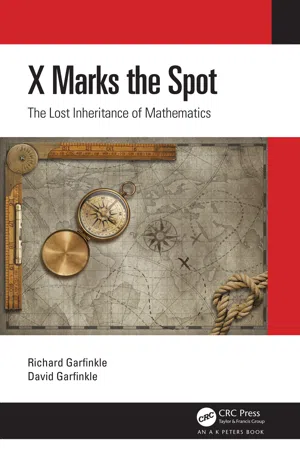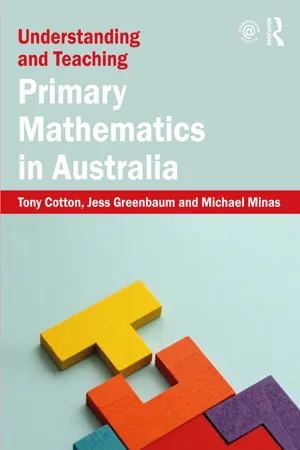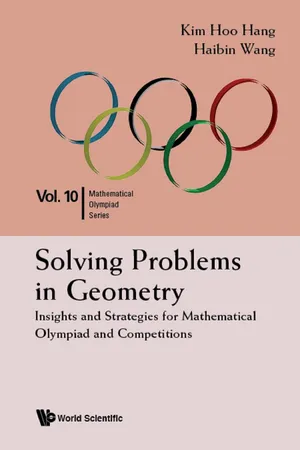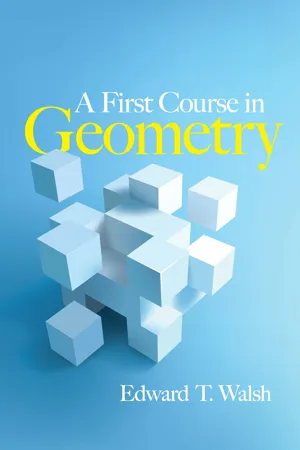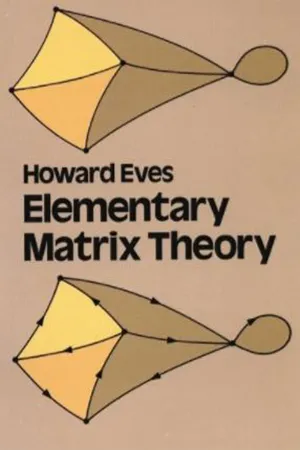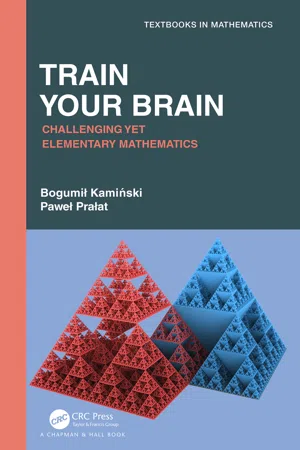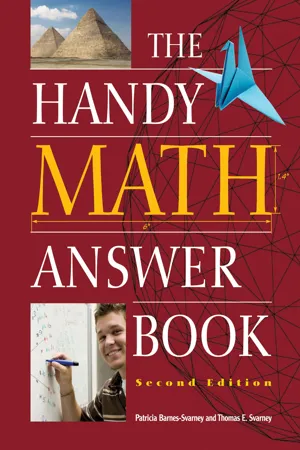Mathematics
Similar and Congruent Shapes
Similar shapes have the same shape but can be different sizes, while congruent shapes are the same shape and size. In mathematics, similarity refers to having the same shape but not necessarily the same size, while congruence refers to having both the same shape and size. These concepts are important in geometry and are used to compare and classify shapes.
Written by Perlego with AI-assistance
Related key terms
Related key terms
1 of 4
Related key terms
1 of 3
8 Key excerpts on "Similar and Congruent Shapes"
- eBook - ePub
X Marks the Spot
The Lost Inheritance of Mathematics
- Richard Garfinkle, David Garfinkle(Authors)
- 2021(Publication Date)
- A K Peters/CRC Press(Publisher)
similar if one shape can be moved around and made uniformly bigger or smaller in order to cover the same set of points as the other.Intuitively, we can see that both congruence and similarity are equivalence relations.For congruence :- Reflexivity : Each shape is certainly congruent to itself since we can move it a distance of 0 and lay it over itself.
- Symmetry : If we can move shape A onto shape B, we can move shape B onto shape A.
- Transitivity : If we can move shape A onto shape B and shape B onto shape C and then if we do the first motion followed by the second motion, we will have moved A onto C.
- For similarity : It’s the same as the above except we also might be making the shape bigger or smaller.
With some work, we could prove this to algebraic satisfaction. Geometry, however, is a bit more practical in its laziness. There are some shapes that get used over and over again in geometry and a decent amount of time was spent creating proofs for when two shapes of these kinds are congruent or similar. Two circles are congruent if they have the same radius, since all you need to do is move one so that it has the same center as the other and behold the same set of points. Any two circles are similar, since if you put one at the same center as the other and then change its radius (which amounts to shrinking or enlarging it) to be equal to the other, you end up with the other circle.A number of tests were created to determine if two triangles were congruent. These always involved comparing the lengths of sides and the sizes of angles. These tests were formulated into rules put in a shorthand of “S” and “A.” For example, the SSS rule says that if two triangles have corresponding sides of equal length, they are congruent. The SAS rule says that if two triangles have two sides and the angle between them is equal, they are congruent. The ASA rule says that if they have two angles and the side between them is equal, they are congruent. - eBook - ePub
- Sylvia Turner, Judith McCulloch(Authors)
- 2017(Publication Date)
- Routledge(Publisher)
For example, a cube is a familiar word that is used in everyday conversation but a cuboid is not. Also words are used inaccurately to describe shape such as ‘round’ for a circle and 2D names for 3D shapes (rectangle for cuboid). Equivalence is a concept that comes in various guises in shape - symmetry, similarity and congruence. Symmetry involves consideration of equivalence and balance within a shape whereas similarity and congruence involve equivalence between two or more shapes. Although work with shape has a strong visual element, many people are not always able to classify shapes as the visual representation can be distorted by their mental image of a shape that has evolved from their experiences. For example, when a group of students was asked to draw a triangle, they generally drew an isosceles or equilateral triangle ‘sitting’ on one side. This is because of the way that triangles are often represented to us as children. Other less familiar triangles presented to the students along with a range of plane shapes were not immediately seen as triangles. The need to return to a definition of a shape based upon numerically based properties became evident. Relating visual representation to language and notation will be explored further in this section. Your mathematics Subject knowledge to teach properties of shape can be divided into three broad areas: 2D shapes, 3D shapes and constructions including nets of shapes. You may find that you have forgotten much of the terminology associated with shape. The specific language used enables shapes to be classified into categories and the process of classification helps us make sense of our experiences. The skills practised through classifying shapes can help children to classify numbers according to their properties. Teachers have to make this connection for children. 2D shapes We can classify 2D shapes according to whether their sides are straight or curved - Tony Cotton, Jess Greenbaum, Michael Minas(Authors)
- 2022(Publication Date)
- Routledge(Publisher)
similar shapes (these are shapes whose sides and angles are all in the same ratio).For example, the two right-angled triangles in Figure 8.2 are similar as one has each side three times bigger than the other one. This also means that thecorresponding anglesin each triangle are the same size.Figure8.2Taking care to develop student’s vocabulary of shape is vital, so make sure there are plenty of displays utilising the vocabulary and also that there is plenty of opportunity to talk about the shapes we are working with.In the 1950s Pierre van Hiele and Dina van Hiele-Geldof, two Dutch mathematics teachers and husband and wife, identified five levels of understanding that help us appreciate how students come to understand shape. These are described in Pierre’s 1999 article “Developing geometric thinking through activities that begin with play” in Teaching Children Mathematics. It is useful for us to explore these levels in some detail before exploring how progression is described by the strategy:Level 0: Visualisation - at this stage students can name and recognise shapes by their appearance. They cannot yet describe properties or use properties to sort shapes. Level 1: Analysis - at this stage students identify properties related to shapes and use these to classify them. Level 2: Informal deduction - at this stage students can use the properties that belong to classes of shapes to problem-solve. So, they will be able to talk about regular and irregular shapes and about triangles in general or specific types of triangles. This is the furthest we would expect most learners to progress within primary school. Level 3: Deduction - eBook - ePub
Solving Problems in Geometry
Insights and Strategies for Mathematical Olympiad and Competitions
- Kim Hoo Hang, Haibin Wang;;;(Authors)
- 2017(Publication Date)
- WSPC(Publisher)
Chapter 2Similar TrianglesSimilar triangles are the natural extension of the study on congruent triangles. While congruent triangles describe a pair of triangles with identical shape and size (area), similar triangles focus on the shape. The diagram below gives an illustration.Indeed, similar triangles are even more powerful tools than congruent triangles. Many interesting properties and important theorems in geometry could be proved by similar triangles.One would see in this chapter that the Intercept Theorem plays a fundamental role in studying similar triangles, while the proof of this theorem is based on an even more fundamental concept: area. 2.1 Area of a TriangleIt is widely known that the area of ΔABC, denoted by [ΔABC] or SΔABC, is given by where h denotes the height on BC.Of course, one may replace BC and h by any side of the triangle and the corresponding height on that side.Notice that implies that if two triangles have equal bases and heights, they must have the same area. Even though this is a simple conclusion, it has a number of (important) variations:• In a trapezium ABCD where AD // BC and AC,BD intersect at E, we have [ΔABC] = [ΔDBC] because both triangles have a common base and equal heights.By substracting [ΔBCE] on both sides of the equation, we have [ΔABE]=[ΔCDE]. Refer to the diagram above.• In a triangle ΔABC where M is the midpoint of BC, we must have [ΔABM]=[ΔACM]. Let D be any point on AM. We also have [ΔBDM]=[ΔCDM]. Refer to the diagram below.It follows that [ΔABD]=[ΔACD]. Since ΔABD and ΔACD have a common base AD, we conclude that the perpendicular distance from B,C respectively to the line AM is the same.Notice that the conclusion above still holds even if D is a point on AM extended. Refer to the diagram below.If M is the midpoint of BC, can you see [ΔABD]=[ΔACD]?• Refer to the diagram below. Given a triangle ΔABC, extend BC to D such that BC = CD. E is a point on AC. Draw a parallelogram CDFE. Connect BE, BF and AF. One sees that the area of the shaded region is equal to the area of ΔABC - eBook - ePub
- Edward T Walsh(Author)
- 2014(Publication Date)
- Dover Publications(Publisher)
Geometry will draw the soul toward truth.PLATOCHAPTER SIX
SIMILARITY
6.1 INTRODUCTION
In the sixth century B.C ., the illustrious mathematician Pythagoras founded a school which adopted the philosophical premise that the examination of everything in nature, geometric forms included, would yield properties that could be expressed in terms of whole numbers. According to legend, the Pythagoreans were onboard ship when one of them demonstrated to the others that, no matter what unit of measure was employed, it was impossible to express the lengths of the legs and hypotenuse of an isosceles right triangle as whole numbers. Since this fact violated Pythagorean doctrine, it was viewed as a serious threat by the Pythagoreans, who responded by throwing its heretical author overboard–or so the story goes.Thus was generated a “crisis” in mathematics which lasted for nearly two hundred years, until Eudoxus invented his elegant and ingenious theory of ratio and proportion. Eudoxus’ work is generally believed to have furnished the entire content of Book V of Euclid’s Elements.In previous chapters, we examined the congruence relation between geometric sets of points. Specifically, we defined congruence for segments, angles, and triangles. When we say that two such figures are congruent, we are saying that they are the same shape and the same size.In this chapter we will begin to consider relations between figures that are the same shape but not necessarily the same size. We have a name for such figures: We say they are similar.Eudoxus’ theory of proportion provides the tools we will use to explore and refine the similarity relation. The notion of similarity will then lead us to a proof of what is known as the Pythagorean Theorem - eBook - ePub
- Howard Eves(Author)
- 2012(Publication Date)
- Dover Publications(Publisher)
5. SIMILARITY AND CONGRUENCE5.1. Similar matrices. Problems. 5.2. Similar matrices (continued). Problems. 5.3. Congruent matrices. Problems. 5.4. Canonical forms under congruency for skew-symmetricmatrices. Problems. 5.5. Canonical forms under congruency for symmetric matrices. Problems. 5.6. Conjunctivity, or Hermitian congruence. Problems. 5.7. Orthogonal matrices and orthogonal similarity. Problems. 5.8. Unitary matrices and unitary similarity. Problems. 5.9. Normal matrices. Problems. ADDENDA. 5.1A. Companion matrices. 5.2A. Regular symmetric matrices. 5.3A. Rotations in 3-space. 5.4A. Cayley’s construction of real orthogonal matrices. 5.5A. The characteristic roots of an orthogonal matrix. 5.6A. Definite, semidefinite, and indefinite real svmmetric matrices. 5.7A. Gram matrices. 5.8A. Some theorems of Autonne. 5.9A. Simultaneous reduction of a pair of quadratic forms. 5.10A. Hadamard matrices.5.1 Similar matrices
In Chapter 2 we considered the important notion of equivalence of matrices. Two m × n matrices A and B, it will be recalled, are equivalent if and only if there exist nonsingular matrices P(n )and Q(m )such that B = QAP. In the present chapter we shall concern ourselves with certain special types of equivalence of matrices, obtained by further restricting the two matrices P and Q in the relation B = QAP. These restricted equivalences find extensive application in various parts of science and mathematics, and just as the notion of general equivalence arises naturally in the consideration of systems of linear equations, the restricted equivalences can be shown to arise naturally in the consideration of some one or other of the applications. It is not our aim, however, to approach the restricted equivalences via applications of them.In this first section of Chapter 5 we briefly examine the special equivalence of matrices known as similarity, a concept that arises naturally in the study of linear transformations.5.1.1 DEFINITION AND NOTATION. Square matrix B is said to be similar to square matrix A, and we write B A, if and only if there exists a nonsingular matrix P such that B = P -1 AP. - eBook - ePub
Train Your Brain
Challenging Yet Elementary Mathematics
- Bogumil Kaminski, Pawel Pralat(Authors)
- 2020(Publication Date)
- Chapman and Hall/CRC(Publisher)
Solution: our own.) 6.2 Congruence SOURCE Problem: Student Circle – High School of Stanisław Staszic in Warsaw Solution: our own PROBLEM Consider a rectangle A B C D. We choose point F such that triangle A B F is equilateral and A F lies inside angle ∢ B A D. Similarly, we choose point E such that triangle B C E is equilateral and B E lies inside angle ∢ A B C. Prove that triangle D E F is equilateral. THEORY Congruence Two figures or objects are congruent if they have the same shape and size, or if one has the same shape and size as the mirror image of the other. It is worth remembering that there are the following conditions for determining congruence between two triangles: three sides of two triangles are equal in length (side-side-side condition); one side and two angles are equal (angle-side-angle or angle-angle-side condition); one angle and two sides associated with this angle are equal (side-angle-side condition); one angle that is not acute and any two sides are equal. Importantly, the exception here is when we know one acute angle and two sides of the triangle but only one of them is adjacent to the angle. In this case, there are actually two possible triangles that meet those conditions but are not congruent. SOLUTION Observe that angles ∢ F A D, ∢ E C D, and ∢ E B F are all equal to π / 6. Also | A D | = | E C | = | E B | and | F A | = | C D | = | B F |. This means that triangles E C D, F A D, and E B F are congruent. In particular, it implies that | E D | = | F D | = | E F | and so D E F is equilateral. FIGURE 6.4: Illustration for Problem 6.2. REMARKS A common strategy when solving geometry problems is to draw a picture and then try to write down all lengths and angles that one can possibly calculate (or list all relationships between them). In our solution, we simply marked the corresponding values for angles and identified sides that have equal length - eBook - ePub
- Patricia Barnes-Svarney, Thomas E Svarney(Authors)
- 2012(Publication Date)
- Visible Ink Press(Publisher)
legs.Isosceles trapezoid —An isosceles trapezoid is one with nonparallel sides that are equal in length, or a trapezoid with a pair of equiangular base angles. The legs of an isosceles trapezoid are congruent. (For more about these figures, see elsewhere in this chapter.)What is a circle?A circle is one of the most fundamental shapes in geometry—and one shape we commonly see every day. For mathematicians, a circle is defined as a set of points on a plane at a certain distance from a center point. In reality, a circle is a polygon with an infinite number of sides.The distance of a line segment from the center to the points on the circle is called the radius (or a line segment whose endpoints are on any point on the circle and its center). A line segment that travels from one endpoint on the circle, through the radius (center of the circle), and to another endpoint directly opposite is called the diameter; two times the radius of a circle is the diameter. The outer perimeter of the circle is called the circumference. The chord of a circle is a line segment whose two endpoints are on the circle. Concentric circles are two or more circles that lie in the same plane and have the same center, but with different radii. Circles with the same radius are called congruent circles. (For more about circle measurements, see elsewhere in this chapter.)The parts of a circle include the center (o), radius (r), diameter (d), and circumference (c). Why are arcs and angles important to circles?Everything starts with the angle whose vertex is at the center of the circle (logically called the central angle of a circle). All the central angles of a circle add up to 360 degrees. Every central angle cuts the circle into two arcs: the minor arc (always less than 180 degrees) and the major arc (always more than 180 degrees). Thus, the measure of the minor arc is actually the measurement of the central angle, while the measurement of the major arc is 360 degrees minus the measure of the central angle. An arc length is the distance between an arc’s endpoints along the path of the circle. Congruent arcs are arcs with the same measurements. When the diameter of a circle separates the circle into two congruent arcs it is called a semicircle.
Index pages curate the most relevant extracts from our library of academic textbooks. They’ve been created using an in-house natural language model (NLM), each adding context and meaning to key research topics.
Explore more topic indexes
Explore more topic indexes
1 of 6
Explore more topic indexes
1 of 4
